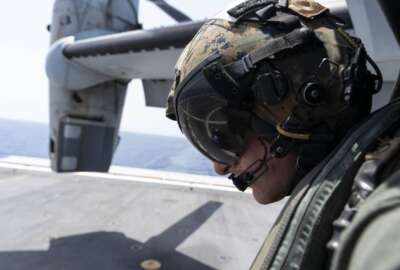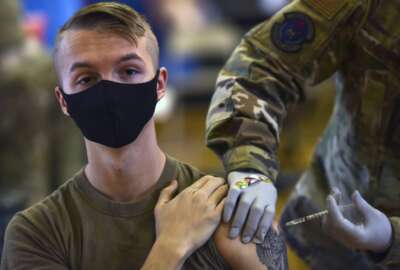Hubbard Radio Washington DC, LLC. All rights reserved. This website is not intended for users located within the European Economic Area.
Punishments start for troops who refuse vaccines
The Navy has outlined its process for discharging sailors who refuse the vaccine. Meanwhile, the Air Force has already started to issue formal reprimands.
The DoD Reporter’s Notebook is a weekly summary of personnel, acquisition, technology and management stories that may have fallen below your radar during the past week, but are nonetheless important. It’s compiled and published each Monday by Federal News Network DoD reporters Jared Serbu and Scott Maucione.
Military service members are starting to face consequences for refusing to get vaccinated against COVID-19. Those punishments range from a reprimand to, in the Navy’s case, removal from the armed forces and a loss of benefits.
The Navy announced Thursday that it has plans to start separating sailors who refuse to get inoculated.
The service said those who are kicked out will receive, at the highest, a general discharge under honorable conditions — paper that could disqualify them from veterans benefits.
Commanding officers must identify those refusing the vaccine, give them medical counseling and report refusing sailors within 30 days.
Service members in senior leadership roles will get a notice from the Navy to begin the vaccination process in five days or request an exemption, otherwise they will be relieved.
Additionally, commands will not allow sailors refusing the vaccine to promote, advance, reenlist or execute orders unless they are exempted.
The Navy is also retaining the authority to take away unvaccinated sailors’ warfare qualifications and other specialties.
Active duty sailors need to be vaccinated by Nov. 14 and reserve sailors need to finish the process by Dec. 14. That means that they get both shots or the single Johnson & Johnson vaccine and two weeks have elapsed from the time of the last shot
“Tragically, there have been 164 deaths within the Navy family due to COVID-19, far exceeding the combined total of all other health or mishap related injuries and deaths over the same time period,” Vice Adm. John Nowell, chief of naval personnel, said in the orders. Almost all of those deaths were from people who were unvaccinated. There are 20 of those people whose vaccination status was not known.
To oversee the discharge process, the Navy is creating a COVID Consolidated Disposition Authority to ensure what a “fair and consistent process” for separation.
About 98% of the Navy’s active duty force is fully vaccinated or have gotten one dose.
So far, the Navy has come out with the strictest policy on those resisting the shot.
The Air Force has sent out formal reprimands to airmen who will miss their shots. The Air Force’s deadline for active duty airmen is Nov. 2, so those who have not gotten their first shot yet will not be in compliance.
The Air Force amn/nco/snco Facebook group posted a reprimand issued from the 319th Reconnaissance Wing at Grand Forks, North Dakota.
The letter, dated Oct. 3, states the airman failed to obey a lawful order.
“You failed to follow a direct order by a superior commissioned officer and by doing so have placed yourself and your fellow airmen in danger,” the reprimand reads. “I can no longer trust you to obey orders that will execute our mission. You have shown you are not committed to maintaining readiness for the Department of the Air Force.”
The reprimand directs the airman to complete a virtual or in-person transition assistance program workshop and obtain and separation history and physical examination in 14 days.
“Your conduct is unacceptable and further deviation or failure to comply may result in more severe action,” the letter reads.
About 84% of active duty airmen are fully vaccinated and 96% have at least one dose.
The military still has serious ground to make up for vaccinations.
“We continue to make progress on this,” said Pentagon spokesman John Kirby last week. “In the total force, for at least one dose we are at 80%. For fully vaccinated across the total force it’s about 65%. The defense secretary’s expectation is that commanders will try to get these troops to make the right decision based on information and education, and for somebody that refuses, they’ll be given a chance to get more context from medical service providers as well as their chain of command.”
“It’s a lawful order, so obviously if after all that effort the lawful order is disobeyed, there could be disciplinary action, but the secretary believes that there’s lots of tools available to leaders, short of using the uniform code of military justice, to get these troops to do the right thing for themselves and for their units,” Kirby continued. — SM
DoD offering booster shots at treatment facilities
The Military Health System is now offering a booster shot to people who have gotten the Pfizer-BioNTech coronavirus vaccine.
Military treatment facilities and Defense Department vaccination sites are offering the shots free of charge.
The Centers for Disease Control and Prevention suggests people get the booster shot six months after completing their second dose of the vaccine.
Health professionals are making a distinction between booster shots and a third dose of the vaccination.
A booster dose is being recommended to increase immunity as it lowers over time. By contrast, a third shot is a full dosage over the vaccine for those with compromised immune systems who did not build up enough antibodies from the original two shots. Third shots are usually given within a month of the second dose.
The CDC says people who should get the booster now include those:
- 65 years and older and residents in long-term care facilities
- 18 and older in long-term care settings
- 50-64 with underlying medical conditions
- 18-49 with underlying medical conditions based on their individual benefits and risks
- 18-64 who are at increased risk of COVID-19 exposure and transmission because of occupational or institutional settings such as teachers, frontline health care workers and essential workers, and those incarcerated, based on their individual benefits and risks.
Booster doses are not part of the Defense Department or federal worker mandates for vaccines.
Proof of an underlying condition or occupational risk is not necessary to get the booster.
The Food and Drug Administration is currently reviewing whether people with the Moderna or Johnson & Johnson vaccines need booster shots. — SM
New DoD R&D boss wants new positions to focus on software, sustainment
The Defense Department’s newly-sworn in undersecretary for research and engineering is planning a fairly significant restructuring of her organization, including by increasing its focus on modern software development methodologies and lowering the long-term sustainment costs of weapons systems while they’re still in their early R&D phases.
Heidi Shyu, who the Senate confirmed as undersecretary in June, said the new organizational chart is still in the works and still needs approval from Deputy Defense Secretary Kathleen Hicks. But she hopes to create at least three new senior positions within DoD’s research and engineering enterprise.
One of the new positions would be Director of Processing and Software to help the department speed its adoption of commercial software practices.
“In the commercial world, software migrates so fast. In the DoD world, they’re starting to adapt some of the commercial best practices, but lagging behind the true software world,” Shyu said in an interview with Federal News Network set to air on Oct. 19. “This is where we’re going to drive the technology of the future software into what we’re doing now, instead of waiting until we develop something, and then try to glue things together.”
Meanwhile, two other new positions would be focused on building modularity and affordability into military weapons systems early in their development.
Shyu said she intends to hire a new Director of Sustainment Technologies within the R&E organization to help “canvas” the non-Defense world for technologies that can help reduce long-term sustainment costs. And a separate director would be in charge of integrating modular open systems architecture into new and forthcoming systems.
“That’s sort of the first step: if we have a modular open architecture, guess what? I can compete elements of the architecture. Anytime you’re doing competition, price goes down, price doesn’t go up, and you can get the latest technology even quicker,” she said. “From leveraging additive manufacturing to leveraging open architecture, there are so many things we can do to reduce costs in the sustainment area.” —JS
Copyright © 2024 Federal News Network. All rights reserved. This website is not intended for users located within the European Economic Area.
Jared Serbu
Jared Serbu is deputy editor of Federal News Network and reports on the Defense Department’s contracting, legislative, workforce and IT issues.
Follow @jserbuWFED
Scott Maucione
Scott Maucione is a defense reporter for Federal News Network and reports on human capital, workforce and the Defense Department at-large.
Follow @smaucioneWFED
Related Stories
Related Topics
Acquisition
Air Force
All News
Centers for Disease Control and Prevention
Contracting
COVID Consolidated Disposition Authority
COVID-19 vaccine
COVID-19 vaccine mandate
Defense
Defense News
DoD Reporter's Notebook
Food and Drug Administration
Heidi Shyu
John Kirby
John Nowell
Management
Military Health System
Navy
Reporter's Notebook
weapons system sustainment
Workforce
Workforce Rights/Governance
Related Stories
-
Navy lays out what will happen to sailors who refuse vaccination Federal Newscast






